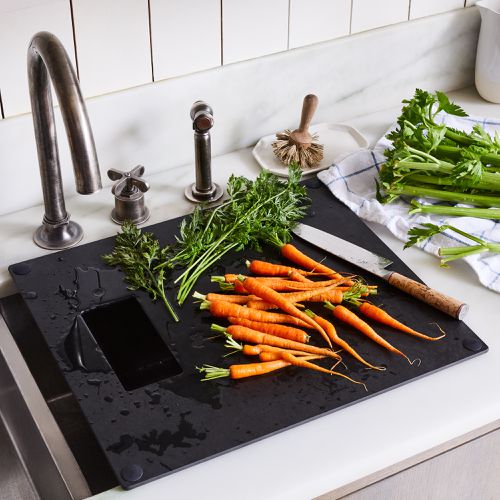


Chip chop.
A real space-saving whiz kid, this black matte cutting board is a boon for smaller kitchens (or those of us who love ourselves a multitasker). It nestles over your sink so you can chop and slice with gusto—then, thanks to a convenient hole on one end, push your scraps, nubs, root ends, and stems into your compost bin for later. It's crafted from natural wood fiber, and oh yes, we designed it in collaboration with Epicurean so you can only get it here. Rubber feet keep it from slipping and sliding while you go to town dicing onions, slicing cucumbers, and julienning carrots. Tough as they come, that eco-friendly wood fiber is built to last while being extra kind to the Earth. A dream to clean, you can pop it right into the dishwasher when it needs a thorough sudsing.
Cut to the chase!
- How to manage crying while cutting onions (we've all been there)
- Make a chopped salad with whatever's lying around
- A mesmerizing video of cilantro (yes, really)
- Made in: Wisconsin
- Shipping & Returns: Free Standard Shipping on Orders $199+ ($14.99 on Orders Below $199) and Easy-Breezy Returns.
17.50" W x 19.75" L W x 0.25" H; 3lbs.
- Materials:
Wood fiber
- Care:
To clean, wash with hot soapy water or run through the dishwasher.
Board is a wood product, and thus can warp if left in wet or damp conditions for long periods of time. To avoid warping, dry surface upright and on edge before storing.
Surface is stain resistant, but can stain when left in contact with highly alkaline products or foods (such as liver, papayas, or beets) for prolonged periods of times. To remove stubborn stains, use a non-abrasive household cleaner.
Epicurean boards are not scratch resistant. If used as a cutting surface, score marks will appear.
Over time, you may find that tiny particles from your cutting board show up on foods you’re preparing or on towels you’re using to wipe it down (especially if yours is slate in color). Don’t fret! This can happen with just about any cutting surface and is due to the nature of the board’s natural wood fiber material. It’s certified by the National Sanitary Foundation to be non-toxic—so go ahead, keep on slicing and dicing.
Meet the Maker
Epicurean
A Similar Style
Our Tips & Stories
How we'd use this beauty in our own homes.

How Dansk’s teak stands the test of time.

We cook from scratch a lot here at Food52 -- yogurt, granola, sriracha, ricotta, bread -- but before we met Stephen Valand and Erica Shea from Brooklyn Brew Shop, we'd never considered making our own beer. We made a video with Erica and Stephen all about the beer brewing process -- be sure to check out Brooklyn Brew Shop and our Shop deal. And when your bottles of custom brew are ready, won't you share one with us?

Have you bought your Brooklyn Brew Shop beer brewing kit yet? If you've watched Amanda learn to make beer, you know that brewing is full of jargon to describe very specific stages of the beer making process. We've collected our top 5 basics below -- try tossing these around next time you visit your local bottle shop.1. Mash - This is just a mix of grains (mostly malted barley and wheat) and water. It looks like porridge, or oatmeal, or...well, mash. After it's simmered, you mash out by bringing it to a certain temperature (this is called mashing out). Then you're on to the next fancy word.Read more for the other 4 terms!



